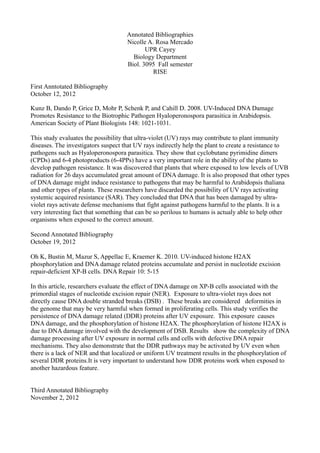
Annotated bibliographies for wordpress
- 1. Annotated Bibliographies Nicolle A. Rosa Mercado UPR Cayey Biology Department Biol. 3095 Fall semester RISE First Anntotated Bibliography October 12, 2012 Kunz B, Dando P, Grice D, Mohr P, Schenk P, and Cahill D. 2008. UV-Induced DNA Damage Promotes Resistance to the Biotrophic Pathogen Hyaloperonospora parasitica in Arabidopsis. American Society of Plant Biologists 148: 1021-1031. This study evaluates the possibility that ultra-violet (UV) rays may contribute to plant immunity diseases. The investigators suspect that UV rays indirectly help the plant to create a resistance to pathogens such as Hyaloperonospora parasitica. They show that cyclobutane pyrimidine dimers (CPDs) and 6-4 photoproducts (6-4PPs) have a very important role in the ability of the plants to develop pathogen resistance. It was discovered that plants that where exposed to low levels of UVB radiation for 26 days accumulated great amount of DNA damage. It is also proposed that other types of DNA damage might induce resistance to pathogens that may be harmful to Arabidopsis thaliana and other types of plants. These researchers have discarded the possibility of UV rays activating systemic acquired resistance (SAR). They concluded that DNA that has been damaged by ultra- violet rays activate defense mechanisms that fight against pathogens harmful to the plants. It is a very interesting fact that something that can be so perilous to humans is actualy able to help other organisms when exposed to the correct amount. Second Annotated Bibliography October 19, 2012 Oh K, Bustin M, Mazur S, Appellac E, Kraemer K. 2010. UV-induced histone H2AX phosphorylation and DNA damage related proteins accumulate and persist in nucleotide excision repair-deficient XP-B cells. DNA Repair 10: 5-15 In this article, researchers evaluate the effect of DNA damage on XP-B cells associated with the primordial stages of nucleotide excision repair (NER). Exposure to ultra-violet rays does not directly cause DNA double stranded breaks (DSB) . These breaks are considered deformities in the genome that may be very harmful when formed in proliferating cells. This study verifies the persistence of DNA damage related (DDR) proteins after UV exposure. This exposure causes DNA damage, and the phosphorylation of histone H2AX. The phosphorylation of histone H2AX is due to DNA damage involved with the development of DSB. Results show the complexity of DNA damage processing after UV exposure in normal cells and cells with defective DNA repair mechanisms. They also demonstrate that the DDR pathways may be activated by UV even when there is a lack of NER and that localized or uniform UV treatment results in the phosphorylation of several DDR proteins.It is very important to understand how DDR proteins work when exposed to another hazardous feature. Third Annotated Bibliography November 2, 2012
- 2. Nijhofa, Joanne W; Muldera, Aat M, Speksnijderb, Ewoud N, Hoogervorstb, Esther M, Mullendersc, Leon H, De Gruijl, Frank R. 2007. Growth stimulation of UV-induced DNA damage retaining epidermal basal cells gives rise to clusters of p53 overexpressing cells. DNA Repair 6:1642-1650 This investigation studies how ultra violet (UV) radiation affects cyclobutane pyrimidine dimers (CPDs) and (6-4) photoproducts ((6-4) PPs). It is hypothesized that CPDs and (6-4) PPs can form clusters of cells that may lead to skin carcinomas. Cells that accumulate CPDs are known as CPD- retaining basal cells (CRBCs). CRBCs may form tumors due to damaged DNA. DNA damage leads to the activation of the wild type p53 protein. The presence of this protein may cause apoptosis. The investigators wanted to know if the CRBCs are precursors of the p53 patches. The methodology of this investigation consisted of exposing mice to UV radiation and treating them with TPA. Afterwards they extracted skin tissue and applied antibodies. These tissue cells were observed under a microscope to obtain the quantity of CPD-retaining cells. The methods used by these investigators are very reliable and relatively simple for any other scientist interested in repeating their experiment.The results of their experiment suggest that the CRBCs were activated by low level of ultra violet radiation. It was also demonstrated that CRBCs are related to the creation of p53 clusters after the applications of 12-O-tetradecanoylphorbol-13-acetate (TPA).